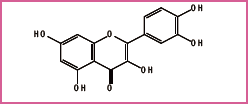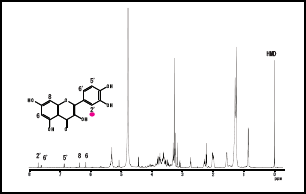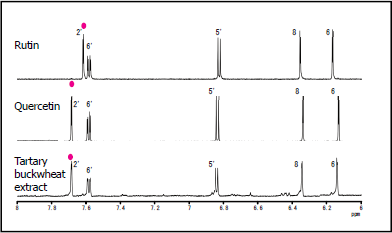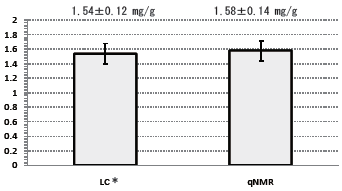Application of qNMR. Part 3:Quantification of quercetin in Tartary buckwheat
NM100008
Target material:Quercetin
Tartary buckwheat, containing functional flavonoid rutin as a main component, gets attention as a healthy food. Rutin, however, is not detected in Tartary buckwheat noodle because of coexisting rutin-degrading enzyme. Instead, another flavonoid quercetin is detected.

Quercetin

Fig. 1 qNMR spectrum of Tartary buckwheat (Spectrometer: JNM-ECA600)
Purpose: Purity of quercetin in extraction liquid of Tartary buckwheat is quantitatively determined by HPLC and qNMR.

Fig. 2 qNMR spectra of commercial reagents of rutin and quercetin and Tartary buckwheat extract.
| Parameter of JNM-ECA600 | |
| Observed nucleus | 1H |
| Observed range | -5ppm~15ppm |
| Data points | 32K |
| Digital filter | ON(8 times) |
| Recycle delay | 60s |
| Flip angle | 90° |
| Scans | 8 scan |
| Temperature | 25℃ |
| Spinning | OFF |
The NMR signals of 6, 8, 5’, 6’-protons for Tartary buckwheat may be attributed to rutin and other flavonoid glycosides, and so the signal of 2-proton is used for analysis.
Conclusion
- Purity of quercetin in Tartary buckwheat was determined by qNMR.
- Purity determined by LC almost agrees with that by qNMR.

Though qNMR is a useful analysis when a target sample of known purity is not avail- able, its sensitivity is lower than chromatog- raphy. However, the combination of these may lead to quantitative analysis with high reliability.

Fig. 3 Purities of quercetin in Tartary buckwheat
* Corrected with the purity determined by qNMR.
Reference
N.Sugimoto, A.Tada, T. Suematsu et al. , Jpn.J.Food Chem.Safety, 17(3),179-184
SEARCH APPLICATIONS
Related Products
Are you a medical professional or personnel engaged in medical care?
No
Please be reminded that these pages are not intended to provide the general public with information about the products.
